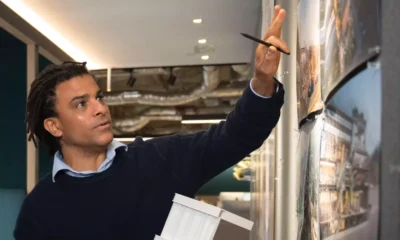Good vibrations inspire industrial designer Ti Chang
Helping women infiltrate the boys’ club of industrial design

When Ti Chang started studying industrial design at Georgia Tech in Atlanta, she never imagined she’d be back in the city 10 years later, teaching women to build vibrators.
Nevertheless, that’s exactly what she was doing at Atlanta’s Museum of Design last summer, having already taken her ‘Build-A-Vibe’ workshop to South by Southwest in Austin, and San Francisco’s California Academy of Sciences, with great success. “The last workshop we did at the Academy of Sciences, we had to turn away about 400 people,” Chang says. “It was insane.”
Though small in stature, Chang wears a determined air of don’t-mess-with-me fearlessness. There’s the large, intricate tattoo on her arm, sure; but, more potent, a palpable sense of courage and conviction. That she would even dream up the Build-A-Vibe workshop, never mind make it a hit, says a lot about the kind of designer she is.
Her products are not just objects, but impart a world view. Crave, the company she co-founded, produces chic, discreet vibrators, the antithesis of typically ridiculous-looking, male-designed contraptions. And, by opting to show her customers how to make them, her world view is clear: more women should be designing and building the products they use.
“It’s my mantra: if you don’t see what you want, build it yourself,” Chang tells me as we arrive at her studio in SOMA, San Francisco’s abandoned warehouse district turned start-up hub (Twitter, Uber and Airbnb are neighbours). Crave is clearly doing well – the company has the whole building, spread over two floors. And it’s thanks to Chang’s mantra that she’s not just busy with Crave these days – she also co-chairs the San Francisco chapter of the Industrial Designers Society of America (IDSA).
“San Francisco is an amazing city with a high calibre of companies and talent, so when I moved here, I was surprised I wasn’t meeting more women at design events,” Chang tells me, as her favourite colleague, Mac the toy poodle, invites himself onto my lap. Taking matters into her own hands, she started a group for female designers on social networking site Meetup.com. It grew to about 350 members, capturing the attention of IDSA, which promptly asked her to help grow its membership.
Chang agreed and, since then, the San Francisco chapter has looked unusual within the wider network: five out of six board members are women. This is a triumph for Chang, who says that after graduating Georgia Tech, “I immediately saw how industrial design is just a good old boys’ club.”
She was confused at first – at least 50 percent of her college class had been female. Then it dawned on her: “Either they weren’t getting the jobs, or they were opting out.” That’s why her Meetup group and the IDSA chapter are so important, she says: “Without a community or some sort of support system [in the industry], it’s very easy for women to just want to leave.”

There may be no better place in the world to keep women enchanted with industrial design. Given San Francisco and neighbouring Silicon Valley are at the forefront of all that’s new and next, Chang’s groups feature women who have worked on seriously high-spec products, from Google glasses to FitBit gadgets. Perhaps here, more than anywhere, there are opportunities for women to show how they can literally help shape a better future.
That’s exactly what Chang’s gunning for. Though she has personally demonstrated the value of women designing products for women, her true message is: “If you want to design products for people and you don’t have a key designer who’s female, you’re missing insights for half your users.” And, she adds, it’s not enough just to have a female researcher onboard: “Then it’s not designed with women in mind, it’s just marketed to them.”
Born in Taiwan, Chang moved to Georgia with her parents aged six, and fell into design after winning a scholarship to Georgia Tech. After taking a stab at architecture, she switched to industrial design. “Just drawing straight lines all day was boring,” she observes of the former.
IF I JUST WANTED TO DO WHATEVER THE HELL I WANT, I’D BE AN ARTIST. I CARE ABOUT CREATING PRODUCTS FOR PEOPLE
Georgia Tech taught Chang to approach design from a user-centric perspective, and it stuck. Her first job out of college, as a graphic designer at a hairbrush manufacturer, was frustrating until she invoked her “build it yourself” mantra: “A lot of these companies just copied other hairbrush designs and changed the colours,” she explains. “They didn’t even know what industrial design was. So I set an appointment with the president, marched in with my portfolio, and walked him through my senior thesis. Next thing you know, he’s put me in charge of a new research and development initiative.”
This led to Chang’s first hairbrush collection, a more ergonomic, gentle model borne from intensive customer research. “I got an email from a mother who said each morning brushing her six-year-old daughter’s hair had been a nightmare, but because of my ‘Ouchless’ hairbrush, her mornings were just that bit easier,” Chang remembers. “That was the first time I felt like: ‘This was all worth it.’” Industrial design is a form of service, in Chang’s opinion. “If I just wanted to do whatever the hell I want, I’d be an artist,” she only half-jokes. “I care about creating products for people.”
This intense focus on ‘UX’ (as Silicon Valley would have it) is what drives Chang’s present success. Her “eureka” moment hit in a Boston sex shop: observing fussy pink monstrosities embellished with cutesy animals – butterflies, dolphins, bunnies – Chang realised the products didn’t just look terrible, but ramped up the stigma around self-pleasure. “After you use something that looks like that, you feel you’ve got to hide it, which is a horrible user experience,” she says. “The object itself reinforces this feeling of shame.” She lays the blame for “pinking” and “cutesying” vibrators firmly at the door of male designers, deadpanning: “I just don’t think it should be at risk of being mistaken for a child’s toy.”
That’s what makes her own take on the space so refreshing – revolutionary, even. Crave’s products are ultra-sleek, made from high-quality materials, such as metals, and wouldn’t call attention to themselves if left out on a dresser. The ‘Bullet’, for example, is the shape and size of a lipstick. The ‘Vesper’ doubles as a necklace and would blend with any jewellery collection. “These products are about feeling good, and shame and stigma has no place in that experience,” Chang says. “My design philosophy was: treat it as a sophisticated, modern product.”
CHANG’S ‘EUREKA’ MOMENT HIT IN A BOSTON SEX SHOP: OBSERVING FUSSY PINK MONSTROSITIES EMBELLISHED WITH CUTESY ANIMALS
The first collection launched under her own brand, INCOQNITO, and sold to several boutique mini-chains (including Good Vibrations and Babeland). Butif it was while showing her second collection at a trade show that she bumped into Michael Topolovac, a serial Silicon Valley entrepreneur, in a taxi queue. It was a fortuitous meeting: Topolovac had just received a chunk of angel seed money to pursue an idea about redesigning vibrators, and was a fan of her stuff. Chang concedes it was a no-brainer: she accepted his offer to buy INCOQNITO, and bring her onboard at his company, Crave.
In the seven years since, Crave has become a profitable business, starting with the launch of the world’s first crowdfunded vibrator. They’d set a target of USD15,000, and raised more than USD100,000. “If the reaction had been different, we’d have been like, OK, maybe we’re ahead of our time,” Chang says.

Instead, they found “a culture that was ready”. This, she points out, shows how “transformative” industrial design can be. “Design is an incredibly powerful tool, and that makes the design community powerful,” she declares. It’s another reason she’s so passionate about networking groups: “Bringing designers together is really crucial to keeping dialogues going, without which there are missed opportunities.”
Crave now sells seven different models and, determined to spread the message further, its visionary leader is about to embark on a new adventure. Along with Mac the dog and an Airstream converted to a Build-A-Vibe workshop, this summer Chang is taking Crave – both the products and the wider conversation – on the road.
It harks back to a childhood fantasy, too; as a little girl, Chang wanted to be a truck driver. She was a different sort of kid, she admits, which didn’t win her too many friends. “But not fitting in is a great thing,” she says. “Sometimes it’s looking at the things no one else is looking at that gets you places you’d never expect.”
This article originally appeared in Issue No. 147 of PropertyGuru Property Report Magazine
Recommended
Meet the architect transforming Asia’s retail spaces with nature-inspired designs
David Buffonge, the cofounder of Hong Kong-based Lead8, has strong opinions on how to improve built environments around Asia
6 sights to check out in Siem Reap, Cambodia
Cambodia’s “temple town” is bolstering its touristfriendly attributes with new infrastructure and residential developments
Inside Asia’s luxury resort residences that are redefining high-end living
Asia’s resort residence market is witnessing a shift as investors eye larger, multifunctional units
How joining BRICS could give Thailand and Malaysia a new economic edge
Thailand and Malaysia are eyeing membership in the bloc of emerging nations








